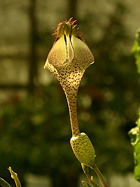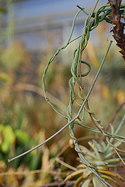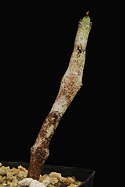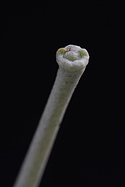This species exhibits a “complex variability” in the words of U Meve in his treatment for the Illustrated Handbook. His discussion acknowledges the Madagascan origin of this species, though the distribution entry erroneously lists several east African countries as well. We received seed of this plant from Herman Petignat under the unpublished name C. truncata. You may wonder, as I did, what about a slender-stemmed, vining plant could possibly be truncate. The seedlings are somewhat thicker-stemmed and grayish with burgundy mottling, but to call them truncate would be a stretch. It was not until our plant flowered after a few years that the possible inspiration for the name became apparent. The plants set fruit freely. These are cryptically colored similar to the stems and have two widely divergent, slender follicles, the tips of which are conspicuously truncate! In fact, they look as though the tip has been inverted like a navel—good name after all. But even if it had been published it would be treated as a synonym of C. albisepta. The latter name refers to the white septa, or divisions, of the expanded corolla lobes, which are ornamented with green to almost black tips. The flowers can be more than two inches long and are variously flecked with red and lined with hairs. Second generation seedlings, the original seed from Petignat’s Arboretum D’Antsokay, located in Toliara (formerly Tulear), on the southwest coast of Madagascar. HBG 98581. $8.

Published in the Cactus and Succulent Journal, Vol. 81 (2), March - April, 2009



